#richard of wallingford
Note
Aegon III and Jaehaera “healing together” would be like:
Jaehaera: I miss my father.
Aegon III, having a PTSD trigger: Well, I miss my mother! AND YOU KNOW WHO GRUESOMELY KILLED MY MOTHER WHILE I WAS WATCHING ?!
Jaehaera: And I miss my twin brother! AND YOU KNOW WHO SEND THE MEN WHO BEHEADED HIM IN FRONT OF ME & MY MOM ?!
Aegon III: Nothing would have happened if your grandmother didn’t usurped my mother and your uncle didn’t ruthlessly murdered my brother.
Their marriage would have been SOOO INCREDIBLY UGLY, BITTER, MISERABLE AND HOPELESS. That union never stood a chance. Aegon III spent about 3 years married to her and never made any attempt to befriend her and had more interactions with Unwin Peake’s daughter than her. They wouldn’t have any children, he’d abdicate in favor of Viserys if he didn’t marry Daenaera and then locked himself in a tower.
Yeah, I agree. I understand that the real English War of the Roses that war/sub-battles ended with a happier and successful marriage between the two warring houses of York and Lancaster so it seems that Aegon III and Jaehaera could have also had a great marriage--or at least a civil one with a lot of kids/heirs. However, though yes we had the structure of "one child of the two warring families marry for peace" of the War of Roses, the Dance was modeled and takes inspiration from the Anarchy. Where Empress Matilda fought against her male cousin, Stephen of Blois, for the English throne. Where the conflict was strictly about who deserves the throne: the female declared heir or the eldest male relative? And who will obtain it, who fights for them, who suffers, etc.
Plus Henry VII of the Plantagenet branch of Tudor (through Jon of Gaunt) & Elizabeth of the house of York--the people who married each other while from the opposing houses after the Battle of Bosworth Field--were both relatively healthy adults AND Henry actually won the throne through his own leadership in battle after killing Richard II (her paternal uncle). The same uncle whose mainly held responsible for Elizabeth's younger brothers' disappearances. So Henry & Elizabeth had a way better beginning than Aegon III & Jaehaera.
Even with the Anarchy, GRRM doesn't transfer all of the events or major ones/results into his fiction. The conclusion of the anarchy was still a woman being passed over: Stephen won and got to rule but Empress Matilda's son--Henry Plantagenet-- was designated as the next to rule in the Treaty of Wallingford. She wasn't brutally murdered in front of said son like Rhaenyra, and despite Stephen's efforts his own sons never sat the throne. But the war ravaged England as the Dance did Westeros enough that in both the lords/barons sought peace above all AND Matilda lost the throne. GRRM seemed to want to capture the sense of futility of the war's destruction. There was no happy-dappy marriage or even an attempt at one in the real thing.
Jaehaera was made totally disadvantaged for a reason:
a) making her and Aegon both children in the aftermath of the war, controlled by ambitious adults still who do not have their best interests at heart makes to highlight theie vulnerability and the cause being misogyny and classism leading those in power to declare such wars
b) their parents fighting and destroying each other to the bitter end instead of what occurred in the actual Anarchy
c) the greens pushed for war under the principle of "men only" at the cost of its female members' mental and physical health or putting those in danger (mainly Helaena and Jaehaera) for the sake of power. Jaehaera could have grown up happier and for longer if her own father hadn't decided to calm down and not try to go after several of Rhaenyra's supporters in the way that he was planning to, nor should he have usurped his older sister. He shouldn't have celebrated Lucerys' murder at the feast he threw that was almost certainly part of the inspiration for Blood & Cheese whereby his oldest male heir was killed. His other male heir was put into danger when he, again, usurped Rhaenyra and led armies against her when she had been already declared and ACCEPTED as Viserys heir for years. All he had left was his daughter left, but bc the whole point of his claim was "males only" AND he was himself an asshole, he decided to marry again to get another male heir. It was also Alicent who tried to intimidate or persuade her granddaughter to kill Aegon as if the child wasn't already scarred from war and mentally fragile from her disabilities so that she, Alicent, could get revenge against the already dead Rhaenyra. The greens, not the blacks or Rhaenyra, are the main ones at fault for Jaehaera's demise--her death is on their hands since every which way, they chose power over her.
#asoiaf asks to me#aegon iii#jaehaera targaryen#fire and blood characters#asoiaf#fire and blood#aegon iii's characterization#aegon iii and jaehaera#english history#medeival history#war of the roses#the anarchy#fiction vs reality#the dance of dragons#fire and blood writing
32 notes
·
View notes
Text
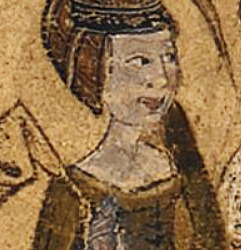
Isabel of Castile, First Duchess of York
Isabel was the third of four children of King Pedro I, also known as Pedro the Cruel, who ruled the Crown of Castile from 1350. Her mother was the vivacious and intelligent Maria de Padilla, often described as Pedro's mistress. In 1361, when Isabel was only six, her mother died. The following year, Pedro declared that he and Maria had been lawfully married before he was forced to espouse his estranged French wife, Blanche of Bourbon, who was by then also dead, some said murdered by her husband. His claim of an earlier marriage was subsequently endorsed by the Cortes, thus legitimising Pedro's children by Maria. Pedro was killed by his illegitimate half-brother and deadly enemy Enrique of Trastámara in March 1369. Trastámara became King Enrique II of Castile.
Isabel accompanied her elder sister Constanza to England, and married Edmund of Langley, son of Edward III and Philippa of Hainault, in 1472 at Wallingford, as part of a dynastic alliance in furtherance of the Plantagenet claim to the crown of Castile. Isabel was only 16 or 17 to Edmund’s 31, and brought him no lands or income or even the promise of such because her sister Constanza – who married Edmund’s elder brother John of Gaunt as his second wife – was their father’s heir. John and Constanza spent many years trying unsuccessfully to claim her late father’s throne from her illegitimate half-uncle Enrique of Trastamara, while Edmund and Isabel were required to give up any claims to the kingdom of Castile and were not compensated.
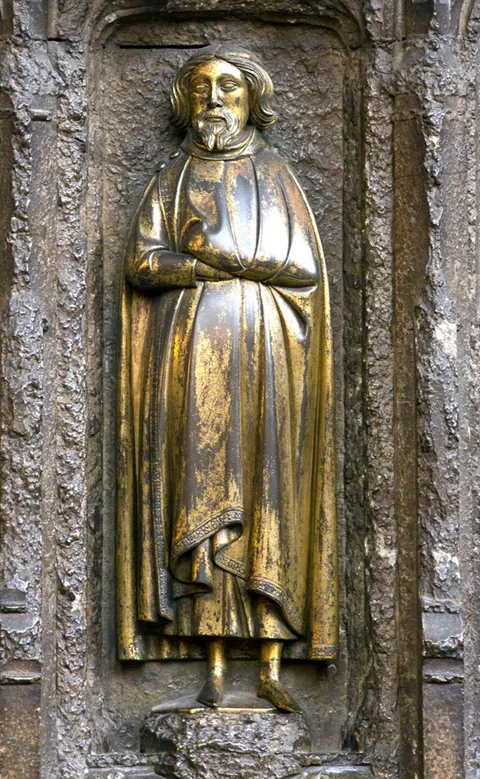
As a result of her marriage, Isabel became the first of a total of eleven women who became Duchess of York. She was appointed a Lady of the Garter in 1379. In their twenty years of marriage, the Duke and Duchess of York had three children:
Edward of Norwich, Duke of York
Constance
Richard of Conisburgh, Earl of Cambridge
Contemporary sources suggest that Edmund and Isabel were an ill-matched pair and their relationship was a rocky one, with Isabel accused of having an affair with John Holland, Duke of Exeter and half-brother to Richard II. The affair is believed to have started as early as 1374 and likely continued for a decade. As a result of her indiscretions, Isabel left behind a tarnished reputation. The chronicler Thomas Walsingham considered her to have somewhat loose morals.
John Holland has also been suggested as the real father of Isabel’s youngest son, Richard of Conisburgh, who was the grandfather of Edward IV and Richard III. The fact that his father Edmund of Langley and brother Edward, both, left him out of their wills has fuelled this theory. However, leaving a son out of your will was not entirely unusual, and Richard had died when his brother made his will.

Isabel of Castile died in December 1392 at the age of about 37 and was buried at Langley Priory in Hertfordshire. In her will, Isabel left items and gifts of money to close relatives by blood or marriage, and to numerous servants of hers, men and women. Isabel referred to Edmund of Langley as her "very honoured lord and husband of York", and left him all her horses, all her beds including the cushions, bedspreads, canopies and everything else that went with them, her best brooch, her best gold cup, and her "large primer". Isabel named King Richard II as her heir, requesting him to grant her younger son, Richard, an annuity of 500 marks. Isabel left nothing at all to her older sister Constanza, duchess of Lancaster, and failed even to mention her. Isabel doesn't forget John Holland in her will, at this time married to Elizabeth of Lancaster, John of Gaunt's daughter.
About 11 months later her widower married Joan Holland, niece of Isabel's supposed lover, John Holland. In another bizarre family twist, it was Joan’s brother, Edmund Holland, Earl of Kent, who had an affair – and an illegitimate daughter – with Constance of York, the daughter of Edmund and Isabel. In Edmund’s own will of 1400 he requested burial ‘near my beloved Isabele, formerly my consort.’ Despite Isabel of Castile's bad reputation and supposedly having been involved in a court scandal that humiliated her husband, Edmund seems to have felt great affection for her as demonstrated by his willingness to rest eternally with Isabel and not with his second wife.
Source:
#Isabel of Castile#Edmund of Langley#Duchess of York#Duke of York#women in history#english history#spanish history
11 notes
·
View notes
Text
“Richard of Wallingford, a fourteenth-century abbot of the Benedictine abbey of Saint Albans (and one of the initiators of Western trigonometry), is well known for the large astronomical clock he designed for that monastery. It has been said that a clock that equaled it in technological sophistication did not appear for at least two centuries. The magnificent clock, a marvel for its time, no longer survives, perhaps having perished amid Henry VIlI's sixteenth-century monastic confiscations. However, Richard's notes on the clock's design have permitted scholars to build a model and even a full-scale reconstruction. In addition to timekeeping, the clock could accurately predict lunar eclipses.”
- Thomas E. Woods Jr., Ph.D., “How the Monks Saved Civilization,” How the Catholic Church Built Western Civilization
4 notes
·
View notes
Text
Top Artists — Medium Term (6 months)
Felbm
Radiohead
Bonnie "Prince" Billy
Kate Bush
Nick Drake
Midlake
Paul Simon
Simon & Garfunkel
Slowdive
Boards of Canada
Canary Room
The Beatles
Fionn Regan
Beach House
Leonard Cohen
hemlock
Vashti Bunyan
Clara Mann
Bob Dylan
The Smiths
ABBA
Grouper
David Bowie
The Clientele
Jessica Pratt
Olovson
Bill Callahan
Laura Marling
Rachel Grimes
Chet Baker
Belle and Sebastian
Sibylle Baier
Aldous Harding
Cocteau Twins
Acetone
Connan Mockasin
Fleetwood Mac
Cornelia Murr
John Martyn
Julie London
Sea Oleena
Sufjan Stevens
Meg Baird
Shannon Lay
Van Morrison
Pink Floyd
Caroline Says
Sun Kil Moon
Maxine Funke
Fairport Convention
that spotify stats page
Top Tracks — Long Term (years)
Calla — Canary Room
4 Lieder, Op. 27, TrV 170: IV. Morgen! — Richard Strauss, Jonas Kaufmann, Helmut Deutsch
6 Melodies, Op. 4 - 6 melodies, Op. 5: Allegretto — Fanny Mendelssohn, Beatrice Rauchs
Long Before Us — Rachel Grimes
Sandalwood I — Jonny Greenwood
Stabat Mater: 1. Stabat Mater — Giovanni Battista Pergolesi, Emma Kirkby, James Bowman, Academy of Ancient Music, Christopher Hogwood
Thaïs / Act 2: Méditation — Jules Massenet, Joshua Bell, Royal Philharmonic Orchestra, Andrew Litton
Songs My Mother Taught Me, Op. 55 No. 4 — Antonín Dvořák, Alisa Weilerstein, Anna Polonsky
Elegy No. 1 in D Major — Giovanni Bottesini, Andrew Burashko, Joel Quarrington
The Carnival of the Animals, R. 125: XIII. The Swan (Arr. for Cello and Piano) — Camille Saint-Saëns, Yo-Yo Ma, Kathryn Stott
Julie With - 2004 Digital Remaster — Brian Eno
wallingford bossa — hemlock
Fantasiestücke, Op. 73: No. 1, Zart und mit Ausdruck — Robert Schumann, Sol Gabetta, Hélène Grimaud
By This River - 2004 Digital Remaster — Brian Eno
Just When You Need Yourself Most — Oberhofer
Gianni Schicchi: O mio babbino caro — Giacomo Puccini, Renée Fleming, London Philharmonic Orchestra, Sir Charles Mackerras
Bleecker Street — Simon & Garfunkel
House of Woodcock — Jonny Greenwood
Shaker — Acetone
All The Time — Acetone
Jazz Suite No. 2: VI. Waltz II — Dmitri Shostakovich, Royal Concertgebouw Orchestra, Riccardo Chailly
Rimsky-Korsakov: Scheherazade, Op. 35: II. The Kalendar Prince (Excerpt) — Nikolai Rimsky-Korsakov, Riccardo Muti, Philadelphia Orchestra
Christine — Canary Room
Me at the Museum, You in the Wintergardens — Tiny Ruins
Valse sentimentale, Op. 51, No. 6 — Pyotr Ilyich Tchaikovsky, Josef Sakonov, London Festival Orchestra
Piano Concerto No. 5 in E-Flat Major, Op. 73 "Emperor": II. Adagio un poco mosso — Ludwig van Beethoven, Wilhelm Kempff, Berliner Philharmoniker, Ferdinand Leitner
Deux Arabesques, L. 66, CD 74: I. Première Arabesque — Claude Debussy, Jean-Efflam Bavouzet
Green Bus — The Innocence Mission
Lucida — Thomas Bartlett
Introduction et Allegro, M. 46 — Maurice Ravel, Oxalys
Two Thousand and Seventeen — Four Tet
When It Rains — Felbm
Lake Effect — Canary Room
Candy Says — The Velvet Underground
Serenade for Strings in C Major, Op. 48, TH 48: II. Valse — Pyotr Ilyich Tchaikovsky, Zagreb Philharmonic Orchestra, Dmitri Kitayenko
Schumann: Davidsbündlertänze, Op. 6, Heft II: No. 14, Zart und singend — Robert Schumann, Jonathan Biss
Magnolia — J.J. Cale
day one — hemlock
Return From The Ice — Acetone
Requiem in D minor, K.626: 6. Benedictus — Wolfgang Amadeus Mozart, Anne Sofie von Otter, Barbara Bonney, Hans Peter Blochwitz, Willard White, English Baroque Soloists, John Eliot Gardiner
River — Terry Reid
Where Should I Meet You? — Canary Room
This Night Has Opened My Eyes - 2011 Remaster — The Smiths
Brother — Vashti Bunyan
Cello Suite No. 1 in G Major, BWV 1007: I. Prélude — Johann Sebastian Bach, Yo-Yo Ma
Sweeten Your Eyes — The Clientele
Knickerbocker Holiday: September Song (Arr. by Paul Bateman) — Kurt Weill, Daniel Hope, Jacques Ammon, Zürcher Kammerorchester
Funicular — Felbm
Piano Sonata No. 12 in F Major, K. 332: II. Adagio — Wolfgang Amadeus Mozart, Jenő Jandó
Sensuela — Column
5 notes
·
View notes
Text
Abbot Richard of Wallingford's Clock

Replica of Richard of Wallingford Clock of St. Alban’s Abbey, St. Alban’s, England, circa 1356 (original)
This is a reconstruction of the oldest purely mechanical clock for which accurate details are known. The original mechanism was designed and constructed for St. Albans Abbey, a town 25 miles north of London, by Richard of Wallingford, the Abbot of St. Alban’s Abbey, but it is no longer in existence. The sole surviving manuscript describing the details of this clock was discovered at the Bodleian Library in 1964 by Dr. John North, who has published detailed descriptions of the mechanism. This reconstruction was made in England, with the assistance of Dr. North, by Peter and lan Howard.
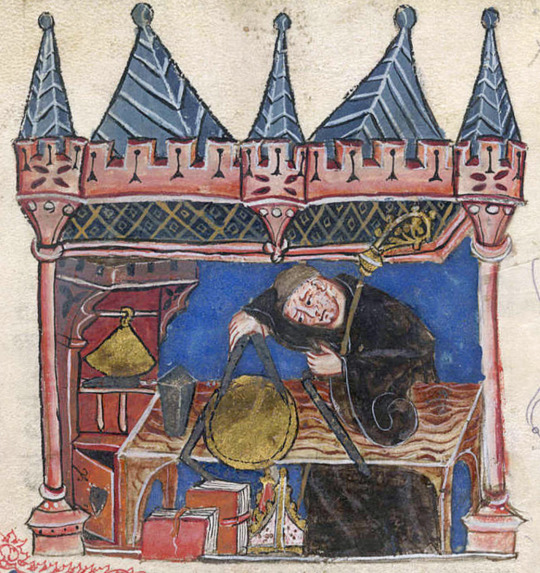
Richard of Wallingford is measuring with a pair of compasses in this 14th-century miniature.
Double wheel verge and folio escapement, 24-hour time dial with 24-hour striking, and astrolabe-type dial indicating the positions of the sun, moon, and the stars, and the eclipses and phases of the moon, and the tide’s ebb and flow.
In addition to its use as an awe-inspiring depiction of God the Clockmaker bringing order to the heavens and earth, recent scholars surmise that its astronomical predictions and the tides helped determine times of planting and harvest and was also used as a means of bringing workers together at the local mills and managing the output of their work.
Historian John Leland saw the clock in the late 1530's when he made an inventory of the monasteries for King Henry VIII and expressed the opinion that it was “second to none in all Europe." This was the last recorded reference to the clock. It is assumed that It was destroyed by Henry VIII during his Protestant Reformation and subsequent dissolution of the monastery in 1539.
#catholic#christian#catholic history#history#science#astronamy#medieval#richard of wallingford#clockwork#protestant reformation#henry viii
24 notes
·
View notes
Text
Gas Works Park
Digital Copy – $5
Gas Works Park sits on the north end of Lake Union in Seattle, Washington. The park is famous for the ruins of the gas works that used to operate on the site. Gas Works Park is also a good location to park and go walking or biking.
Activities in and near Gas Works Park
Gas Work’s Park is in the middle of Seattle. This makes it a good place to see several Seattle’s sights and…

View On WordPress
0 notes
Text
BCI - STUDIO ENTERPRISE 2 (KKB285) – SEM 1 2022 KKB285 Assessment 1 – Creative Concept Journal - Maritime Green Concept Brief.
http://paul-campo-campion-blog.tumblr.com/
‘Climb High’ at North Shore, to a totally immersive experience, offering adventure, fun, and a view like no other. Inside, journey through the cultural heritage of our First Nations people and the area’s maritime history. From the top viewing deck and rock-climbing wall, breath-taking Brisbane River and city views await.
Monday, March 14
My name is Paul Campion. I will be working on a creative brief for Economic Development Queensland (EDQ). The brief requires an innovative concept that will put the spotlight on North Shore's indigenous, industrial and maritime history, in addition to its distinctive riverfront features and immersive experiences including food and festivities. My concept will attract a young audience (5 to 18yrs) and deliver a sustainable pathway for future generations.
Tuesday, March 15
I was fortunate enough to be taken on a tour of North Shore by the client. I discovered an open area that to me is a work in progress. I didn’t find the place attractive enough to want to spend time there with my family, as I felt there was nothing really to do, except sit and look at the river. Even then, the view offered was limited from ground level, behind a fence. In alignment with the brief, I would like to take on the challenge to deliver a concept that encourages parents and their kids to come here any day of the week, at any time, to enjoy an experience that will make them want to come back. Some of the photos I took of North Shore are below.


Wednesday, March 16
Following the site tour, one feature missing was a lookout and there was nothing for kids to do.
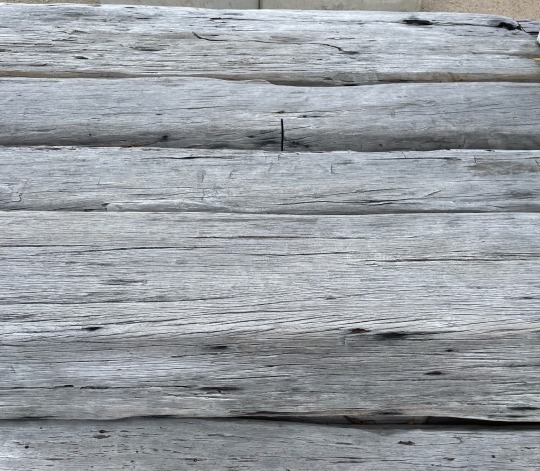
Thursday, March 17
My concept is to use existing shipping containers to create a rock climbing area on the site. The outside of the containers will be used for rock climbing and the inside walls, for a staircase that will open up onto a viewing deck at the top of a horizontal shipping container. Recycled wooden wharf logs can be cut and used for the steps inside the containers. The cost of this structure will work within the 40 to 70 thousand dollar budget, and the timeframe to build it will be a short-term project of a maximum of 12 weeks. The structure will also feature murals by local artists, to reflect the culture and history of the site. The structure will attract schools throughout the week for fun climbing adventures, and this exposure will influence people to visit and use the structure regularly. Maintenance of the structure will be low cost, with long-term sustainability. Below is the structure I have designed to specifications.


Thursday, March 17
My creative concept fits with North Shore's branding by bringing an immersive and interactive experience to the site. At the moment, North Shore offers no real physical activity, and therefore, the rock climbing wall would fill the need/gap. My concept adds value to the area by attracting students, families, and adventure seekers to the North Shore. Placing a viewing deck above the rock climbing wall also provides visitors with an opportunity to view Brisbane and its river from a unique and immersive perspective. While creative tourism must be linked to culture, Bonink and Hitters (2001), assert that particular cultural attractions are to be unique to each place and can gain their distinctiveness and uniqueness through elements of local identity or 'brand'. My concept also offers talented local artists, the opportunity to be employed to create murals, which reflect the indigenous and maritime history of our local area and transpose Northshore as a vibrant and unique 'place to be' (Bonink and Hitters 2001).
Bonink, C., Hitters, E. (2001). Creative Industries as Milieux of Innovation: the Westergasfabriek, Amsterdam. In Cultural Attractions and European Tourism; Richards, G., Ed.; Cabi Publishing: Wallingford, UK, 2001; pp. 227–240.
Thursday, March 17
The cost and logistics for the rock climbing wall will include timber cutting, architectural design, boilermakers and steel cutters, deck builders, safety analysis, staircase designers, structural engineering, and consulting within a 70 thousand dollar budget. EDQ will oversee the project to ensure specifications are met and that the criteria specified, fits in with the North Shore Maritime Green area. Insurance costs will also be required. Everything will need to be signed off by EDQ. Some of the challenges will be to provide structurally safe facilities for users while keeping within budget constraints.
Thursday, March 17
The shipping container climbing project will also need architectural design and structural engineering to meet safety standards. Professional climbing consultants will be involved in the project, in addition to builders, cabinet makers, boilermakers, and deck builders. EDQ will oversee the project to keep costs to a minimum by using materials already on-site, such as the shipping containers and wooden logs and beams. The climbing facilities could be used as a training facility for rock climbers leading up to the 2032 Olympic Games in Brisbane.
Thursday, March 17
I discovered on LinkedIn, that EDQ is also asking for expressions of interest from the public to develop the North Shore site. This could be a threat to the pitch https://northshorebrisbane.com.au/eoi/
Friday, March 18
I have looked at other examples of rock climbing walls made from shipping containers and they are excellent attractions, honing in on youth and fitness. 'Every kid loves to climb' is the motto.
Friday, March 18
According to Kirshenblatt-Gimblett (1998), creative spaces depend on the way a person of a particular background perceives and reacts to the world, therefore the place's identity must be integrated and its past heritage and distinctiveness must be showcased. The indigenous and maritime murals on the rock climbing walls that portray the history of North Shore will make it one of the most eye-catching and culturally relevant art pieces in Brisbane.
Kirshenblatt-Gimblett, B. (1998). Destination Culture. Tourism, Museums, and Heritage; University of California Press: Berkeley, CA, USA.
Monday, March 21
Today, I spoke with a representative from the North Shore urban renewal project. The project is looking for permanent operators.
Tuesday, March 22
In 2032, more than 10,000 athletes and officials, along with 5000 Paralympians, will converge on Brisbane for the Olympic games, where a predicted 8 billion dollars in benefits will be injected into the local economy and across the state. Playing the part of the Athletes Village for the Olympics will be North Shore. Its redevelopment will be comparable to Southbank, after expo 88 and more than 90 thousand jobs will be on offer. My concept needs to be sustainable until the Olympics and beyond, and therefore, I wish to create an immersive experience within the North Shore precinct that will be a must-do destination for all visitors of Brisbane to enjoy. My vision is a synthesis of the community's sporting organizations, tourism operators, and local businesses, to be able to utilize the facilities to attract more customers and visitors to the area, which are necessary for its survival.
Wednesday, March 23.
The sustainability of the shipping container rock climbing wall will be dependent on its immediate success in attracting people to North Shore.
Thursday, March 24.
I have based my concept on the activities that my 13-year-old daughter, Georgia, and her friends, have been participating in since they were about 8 years of age. Georgia is a very active young lady who plays tennis and likes swimming. Photos below show Georgia and her friends, rock climbing at 8 years of age (bottom) and again at 13 (top).



Saturday, March 25.
Like my daughter Georgia, my target audience will be active school kids from 8 to 18 years of age, who love new experiences with their friends, who wish to test themselves, and maybe even overcome some obstacles, such as fear of heights. Rock climbing is a confidence builder for school kids and the benefits of climbing are enormous (Discoveryclimbing, 2022). Schools from all over Brisbane will be able to bring groups of kids for a day of fun and adventure at Maritime Green. (Discoveryclimbing, 2022).
Discoveryclimbing. (2022). How Climbing Creates Confident Children. https://discoveryclimbing.com.au/2022/03/18/how-climbing-creates-confident-children/ .
Sunday, March 26.
On their climb to the viewing deck above, parents, teachers, and students will enjoy learning about the area's history on the walls inside the shipping containers. On reaching the viewing deck above the rock climbers, visitors will have the ultimate view of Brisbane and its magnificent river. Community groups and tourism operators will find the facilities a drawcard for visitors to the region.
Monday, March 27.
Schools will pay a group booking fee for the opportunity to bring classes of students to the rock climbing. Rock climbing experts will be required to supervise and guide children through the experience and teachers will also require training as supervisors as rope handlers and as climbing supervisors for the kids. EDQ will offer rock climbing courses for teachers and students.
Tuesday, March 28.
The shipping containers will be painted with indigenous murals and maritime history, and both indigenous artists and local canvas artists will combine their talents to create an artistic talking point for the North Shore. Inside the shipping containers, an ensemble of both indigenous and maritime historical photos and written history will don the walls leading up to the open-air top viewing deck.

Tuesday, March 28.
Ongoing maintenance will be required for the shipping containers, and regular health and safety inspections will be required for the upkeep of what promises to be a major drawcard for the Maritime Green.
Budget:

2 notes
·
View notes
Text
“After the coronation ceremony in December 1154, Eleanor and Henry II both remained in their new kingdom for over a year until, in January 1156, the king left for France to contend with his brother Geoffrey’s rebellion in Anjou. Eleanor, often parted from her husband for long periods when he was fighting on England’s frontiers or on campaigns in his French lands, may have experienced feelings of isolation in England from time to time. Adding to the queen’s loneliness was her inability to have the company of more than a handful of her fellow Poitevins serving in her household.
Eleanor, living in the midst of foreigners withholding from her the admiration accorded their earlier queens and whose language she never learned to speak, may have faced her days in England with some foreboding. Henry’s frequent absences from his kingdom would become a cause of concern for his English subjects. In a letter addressed to the king by the archbishop of Canterbury in spring 1160, he was urged to return to England, and reminded of his offspring, “those children from the sight of whom scarce even the hardest-hearted father could any longer withhold his gaze.”
While in England, Henry had much work to do, taking him away from his queen’s side in his task of reversing the diminution of royal rights during the civil war under King Stephen. Not long after his coronation, he headed for the north to reassert royal power there, while Eleanor remained behind at Bermondsey in the last stage of her second pregnancy by the English king. When Eleanor gave birth to their second son on 28 February 1155, Henry II was in Northampton. This was their first child “born to the purple,” and he was named Henry to commemorate his great-grandfather King Henry I of England, linking the boy to the Anglo-Norman royal line.
At the end of March, the king returned from his northern expedition in time for the Easter festivities at Merton Abbey, and afterward he held a great council at London, where Eleanor had a prominent part in the festivities as the mother of two young princes. Two weeks later another council took place at Wallingford, where little William and his month-old brother were presented to the assembled magnates. The king, mindful of the uncertainty about the succession that had caused years of civil war, 1139–53, insisted that his barons swear their fealty to William and to his infant brother Henry.
By June, Henry had left his wife’s side again to go on campaign, this time in the west country, conducting sieges of castles at Bridgnorth, Wigmore, and Cleobury. Eleanor would be separated from her husband for much of 1156, for Henry II crossed the Channel to Normandy in January on his first visit to his Continental lands as English king. He would be absent from his kingdom for the entire year, not returning to England until April 1157, while Eleanor remained in England acting as regent. Some time during Henry’s absence, William died at the age of three, although the date of his death is not known.
Henry had left Eleanor pregnant for a third time, and in June 1156 she gave birth to a daughter, christened Matilda. The name linked the child to her Anglo-Norman ancestors, honoring her grandmother, the former German empress, whose own mother, William the Conqueror’s wife, had also borne the name Matilda. Eleanor’s first two children born in England were both christened by Archbishop Theobald of Canterbury at Holy Trinity, Aldgate, a London house of Augustinian canons founded by Henry’s grandmother, Henry I’s queen. Eleanor joined her husband at Angers in the summer of 1156, following William’s death. On that Continental sojourn, she took with her both Young Henry and the infant Matilda, no more than three months old.
The following autumn the royal couple would make a tour together of Eleanor’s duchy of Aquitaine, her first visit to her people in over two years. On this first visit since their coronation as king and queen of England, they revisited Limoges. Henry II intervened again in the Limousin to enforce his lordship, this time in the succession to the territory, enforcing his right as lord to guardianship over the deceased viscount’s minor son, even though previous count-dukes had not exercised such a privilege. He claimed custody of young Aymar V, and placed the viscounty in the hands of two Norman officials, despite the boy’s paternal uncles’ claim that tradition gave them the guardianship by their right as his closest kin.
Later Henry would take advantage of his lordship to arrange the young viscount’s marriage to a daughter of his uncle, the powerful Earl Reginald of Cornwall. Such “feudal” prerogatives of lordship were not customary in Eleanor’s lands, and Henry’s attempted introduction of them would not be appreciated by her nobility. From Limoges, Eleanor and Henry continued south, visiting Bordeaux at the invitation of her former guardian Archbishop Geoffrey du Loroux. The state visit to Eleanor’s lands culminated with a Christmas court at Bordeaux, where Henry proclaimed his peace to the nobility and people of Gascony.
This ceremony marked the end of Eleanor’s autonomy as ruler of her duchy. The five surviving documents issued by her as duchess during her 1156 visit reveal the limits of her authority over her ancestral lands, for three are merely confirmations of Henry’s acts. The two documents that Eleanor issued, evidently without Henry’s sanction, are routine orders to her Poitevin local agents to observe her father’s grants of privileges to religious houses. After this visit, Eleanor’s name disappears from Aquitanian charters, and none recording her as grantor, either alone or jointly with her husband, is found until her return over a decade later.
During those years, Henry was issuing charters for his wife’s subjects in Poitou with no mention of her consent, although many of them were likely confirmations of grants originally made by her. Following the Christmas court at Bordeaux, the queen returned to England with her children early in 1157, pregnant once more, to resume her duties as regent until Henry’s arrival in April. Neither Eleanor nor Henry would visit her duchy again until 1159 at the beginning of the failed Toulouse campaign. Prolonged visits to Eleanor’s lands by Henry were rare, and most were no more than a month long.
Two years after the 1156 visit, Henry would tangle with the viscount of Thouars, the most important noble in the northern and western parts of Poitou with territory stretching from his ancient fortress at Thouars, guarding the Poitevin frontier below the River Loire south of Saumur to the Atlantic coast near the Île d’Oléron. Henry took the castle of Thouars in 1158 after a three-day siege and then sent the viscount into exile, ruling his territory through Angevin or Norman appointees. Supposedly Henry had moved against the viscount of Thouars because of his support for Henry’s rebellious younger brother, Geoffrey count of Nantes; but according to some accounts, he acted out of a desire to please Eleanor, who considered the viscount a quarrelsome vassal.
She counseled Henry to forceful action, urging him to raze the castle and its walls just as earlier she had pressed her first husband for strong measures against the Poitevins. Whatever the cause, Henry’s brutality toward the viscount only alienated the nobles of Eleanor’s duchy. The Poitevin nobility viewed Henry Plantagenet as tampering with their traditional “liberties” in his attempt to transform vague ties that had bound them to Eleanor’s predecessors into defined duties owed to him as lord. As usual, the instigators of resistance were the lords along Poitou’s southern frontier in the lower Charente and upper Vienne valleys, most prominent among them the counts of Angoulême.
Despite the English king’s success in taking custody of the minor viscount of Limoges, the great men of Poitou rejected his “feudal” right to wardship and marriage, and Henry would never succeed in imposing on them the obligations owed by his Norman and English nobles. Nor would they admit that they held their lands of him as count-duke conditionally in return for payments and services; they only acknowledged a longstanding duty as landowners to perform ancient “public” services. Eleanor had urged Louis VII to strong measures against her subjects, but eventually she would come to see Henry’s authoritarian actions against the Poitevin aristocracy as contrary to her homeland’s traditions and her sympathies would shift toward her own people.
After Eleanor’s return from Poitou, she would remain in England throughout the summer and autumn of 1157, and on 8 September she was at Oxford, where another son Richard was born. The source of Richard’s name is uncertain; it had been borne by several Norman dukes, but Robert was also a common name in the ducal lineage of Normandy. Henry on rejoining his family in England in April 1157 would remain in his island kingdom for fifteen months, except for a Christmas visit to Normandy with Eleanor for the Christmas court at Cherbourg. In mid-August 1158, the king left again for a long absence of four and a half years, not returning until late January 1163.
Eleanor would recross the Channel to join her husband for the 1158 Christmas court at Cherbourg, leaving her infant son Geoffrey behind in England little more than two months after his birth on 23 September 1158. Geoffrey’s name, of course, honored Henry’s own father, Count Geoffrey of Anjou. The name Fulk that alternated with Geoffrey as a male name in the comital family of Anjou was also available for one of the sons, but never selected. Eleanor’s own ancestors afforded no additional choices, since all dukes of Aquitaine took the name William.”
- Ralph V. Turner, “Once More a Queen and Mother: England, 1154–1168.” in Eleanor of Aquitaine: Queen of France, Queen of England
#eleanor of aquitaine#eleanor of aquitaine: queen of france queen of england#history#high middle ages#medieval#ralph v. turner#henry ii of england
15 notes
·
View notes
Text
The area of Essex called Essex Village was originally named Potapoug Point, or Big Point, by the Nahantic tribe. It was laid out as a part of the original Saybrook colony in 1648. It bordered the Connecticut River with two large coves on either side. There were three original families: the Pratts, the Hides, and the Lays. The Lays took the northern parts, the Pratts the middle acres, and the Hides the southern acres. In 1722 the settlers were given the right to form a Congregation Church, which was located in Center-Brooke, the original “social center” of what is now the Town of Essex. Main Street on the "point" was not laid out until 1748, and up to that time only a few people resided here.
By the middle of the 18th century, however, the focus was already moving to Potapoug Point, or Essex Village as we now know it, where shipbuilding was beginning to offer an alternate occupation to farming. The building of the ship “Oliver Cromwell” in 1775/76 by Captain Uriah Hayden could be considered the pivotal change in the local economy. The Oliver Cromwell was the first ship commissioned and financed by the Colony of Connecticut and the largest one launched in the river valley up to that time. The Town of Essex itself was split from Old Saybrook, and was incorporated in 1854, and in 1859, the villages of Centerbrook and Ivoryton were added. Shipbuilding remained a main economic force until the 1870s.

1. The Essex Town Green was originally the site of three homes. The Town Green borders Middle Cove and looks out onto Thatchbed Island.
2. The Gamaliel Conklin House, a center chimney, colonial style home with a steeply pitched roof, was built in 1800. Conklin, along with Jesse Murray, was a supplier of masts, blocks, and gear for the shipbuilding industry. 20 Main Street.
3. Next door is the Jesse Murray house, built in 1805, is in the Federal Style. 22 Main Street.
4. Uriah Hayden House. 24 Main Street. Uriah was the man most responsible for establishing a formal shipbuilding industry in Essex. Meigs Lane was once a pentway. This house was modeled after the new Baptist church, built by Jeremiah Gladding, in the “Egyptian style.” Additions have been added since.
5. 26 Main Street. Cape house on water. 1803.
6. The Noah Pratt house, 28 Main Street. Built in 1805 on land original known as Cornfield point. The house was sold to Uriah Hayden in 1817 and remained in the Hayden family until 1977. It now houses Commercial offices.
7. 30 Main Street, at the corner of Parker Lane, was erected in 1840 for Judge William Phelps. It was later owned by Dr. Charles H. Hubbard (1836-1908), who practiced in Essex for nearly forty-eight years. He also held various town offices and was the executor for the estate of Capt. Isaiah Pratt (1814-1879), who had left money for a new high school. Dr. Hubbard successfully challenged a stipulation in the will that would have limited enrollment to the children of parents who were members of the First Congregational Church. He continued as a trustee and leader of the new school for many years. Hubbard Field in Essex is named for him. The barn in back is newly constructed. Considered Greek Revival.
8. 32 Main Street. 1799. Grover L’Hommedieu (1741-1841) was one of the patriot militiamen who became refugees from Long Island to Connecticut after the Battle of Long Island in 1776 during the Revolutionary War. He settled in Norwich and in 1797 leased land from Samuel Lay in Essex. There he erected the town’s first ropewalk. Around that time he also erected the house at 32 Main Street in Essex. It was later occupied by his son Ezra L’Hommedieu (1772-1860), a ship-carver who invented the double-podded center screw auger, which he patented in 1809. Grover’s daughter Sarah (Sally) married Ebenezer Hayden II, the town’s leading merchant. In 1802, Grover L’Hommedieu sold the ropewalk to his partner, Ebenezer’s son, Jared. In 1815, the L’Hommedieu House was purchased by another member of the Hayden family, John G. Hayden.
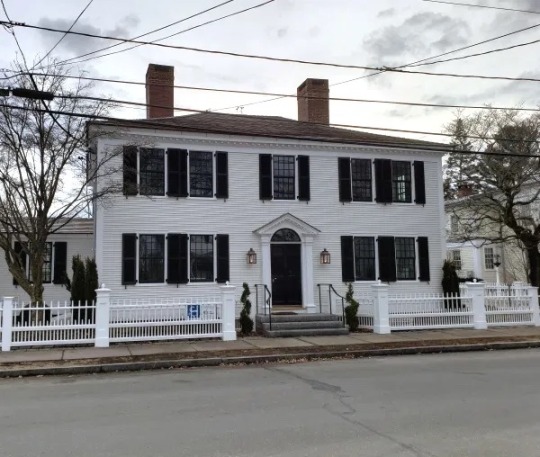
9. The L’ Hommedieu Ropewalk. Essex had two ropewalks, in different locations, at different times. L'Hommideau had "lately erected" a frame that was 15' wide by 60 rods (1000') long that ran on the north side of Main Street. This meant it ran from the west side of the current "Glass Basket" building to where Essex Square is today. There was a 20' wide "store" at the west end of this ropewalk, and the land rent was 4 pounds per year. Main Street followed a different path at that time, being located roughly halfway between current Main and Pratt Streets, and there was no Essex Square or North Main Street then. Grover was allowed to have a "copper"(large tar kettle) and a capstan for winding rope on the north side of this structure, although these were on Lay property. This "frame" was said to be "open," indicating it probably had a roof, but no sidewalls. Consequently, it was probably operated on a seasonal basis. It was torn down in 1814.
10. The Griswold Inn, oldest continuously operating Inn in America is at at 36 Main Street. The Griswold Inn is the most famous landmark building in Essex. A sign at the Inn states that the Griswold House was built by Sala Griswold in 1776. It originally stood near the shipyard and was moved to its current location on Main Street to become part of the house constructed by Richard Hayden in 1801. Hayden’s house was the first three-story building in the lower Connecticut River Valley. Around the same time, Richard’s two brothers, John G. and Amasa Hayden, built houses on either side (they are now part of the Griswold Inn complex, the Amasa Hayden House being the Inn’s annex). Hayden sold his house to Ethan Bushnell in 1806, moving to a new brick house nearby. Ethan Bushnell turned his home into a tavern. A former schoolhouse on the property, built in 1738, was attached to the house, possibly to serve as a kitchen (it is now the taproom). After the Burning of the ships in 1812, it notoriously served and housed British soldiers. The Tavern was inherited by Bushnell’s children in 1849 and passed through a variety of owners over the years, probably acquiring the name Griswold House during the period it was owned by Emory Morse of Wallingford in the 1870s and 1880.
The Griswold Inn starred in Halmark’s “Christmas at Pemberley Manor” movie. And had a role in the 70’s Dark Shadows series as the Collinsport Inn. Owned by only six families. Currently owned by Geoff Paul, who lives in Champlin Square.


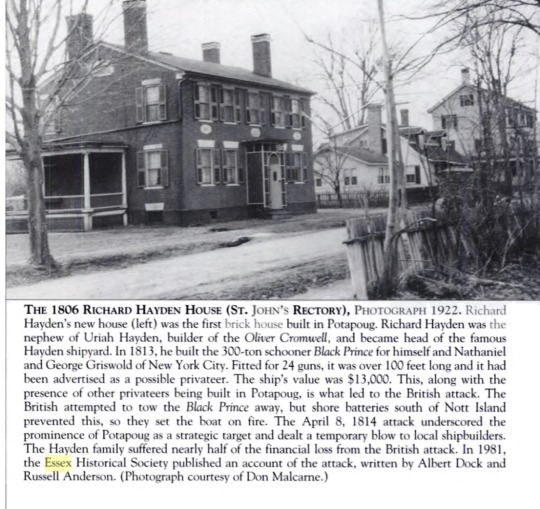
12. Richard Hayden house/ Hayden rectory. 1806. Richard Hayden, an Essex shipbuilder and merchant, built the first brick house in town in 1806. He had earlier lived in the house which is now the Griswold Inn. Hayden was head of the Hayden Shipyard and he built a ship’s chandlery in 1813, which was later moved across Main Street. During the War of 1812, he built a privateer schooner, the Black Prince, which he advertised in New York. This was one of the causes of the British Raid on Essex in 1814, which led to serious financial losses for Hayden, who died two years later. His widow and children remained in the Federal-style house until 1833, when Richard Hayden’s cousin, Samuel Hayden, bought the house. In 1894, Samuel’s daughter, Mary Tucker, left the house and furniture to St. John’s Episcopal Parish and was the church’s rectory until 2013.
13. Noah Tooker house. 1728. At corner of Novelty Lane. May have faced the river, then turned when the rectory was built. Several other houses in Essex were built to face the river and remain so sited today.
14. The Ebenezer Hayden II (the first Ebenezer Hayden was a brother who was born earlier but had died) probably built his Georgian and Federal style house, located on Main Street in Essex, in stages in the late 1790s. The doorway, featuring a semi-circular fanlight window, may have been added around 1800. The Hayden House was the first home in the lower Connecticut River Valley to have a hipped roof, which may have been constructed by the noted builder Thomas Hayden of Windsor and shipped down the river in sections to be placed on the building. The Ebenezer Hayden House is the third home up from the river and one of many homes built by members of the Hayden family in the vicinity of the Hayden Shipyard. Ebenezer II married Sarah, the daughter of Grover L’Hommideau, who had created the town’s first ropewalk.
15. Foot of Main, the Hayden-Starkey Store, at 48 Main Street in Essex, was only the second brick building in town when it was built in 1809. A warehouse and ships store, or chandlery, it was constructed by Samuel and Ebenezer Hayden, sons of Capt. Uriah Hayden, and was situated between their two residences. Their cousin, Richard Hayden, had recently built his house, Essex’s first brick building, nearby. Timothy Starkey, Jr., the Hayden brothers’ brother-in-law, became their partner in 1810. It is said that the British destroyed ropewalk and took merchandise from this store during their raid on Essex in 1814. Remaining in the Hayden family for many years, the building became a residence in 1856.

16. Uriah and Ann’s Inn. Now the Dauntless Boat Club. Built in 1776, this important structure was the homestead and tavern of shipbuilder Uriah and Ann Hayden. The Oliver Cromwell ship was built in his shipyard to the south of the house in 1776. The front yard has been filled in. To the southeast on Middle cove shore, where the Essex Corinthian Yacht club, Essex Yacht club, and Novelty Lane now stand, was the location of the Old Shoddy Mill, a wood turning factory which burned down in 1900. It was once owned by Thomas Dickinson, who went on to found the Witch Hazel factory.
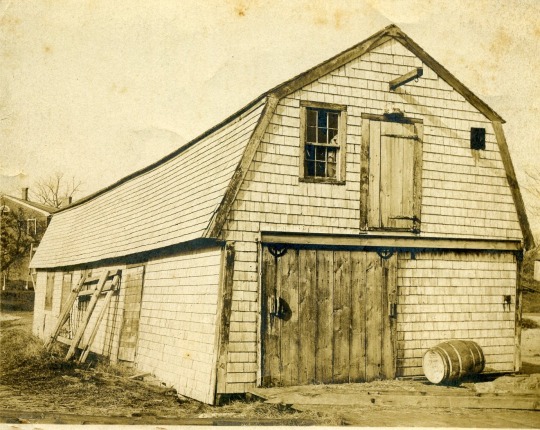
17. Dickinson Boathouse, built by E.E. Dickinson of Witch hazel factory fame in the 1920’s. It replaced a West Indies warehouse that was built in 1753 and torn down in 1918. The building is now in privately owned.

18. Burning of the ships. The embargo that President Thomas Jefferson passed, followed by the British blockade of the Connecticut River during the War of 1812, impacted the shipbuilding industry of the town. The leading boat builders were converting their merchant ships into privateers in the hope of bringing home some of the spoils of war, but this act backfired. On the morning of April 8, 1814, 137 British marines and sailors, under the command of Captain Richard Coote, raided Potapoug Point and destroyed 28 ships with a value of $200,000. Of which, $60,000 was lost by the Haydens. The disaster, one of the few invasions and occupation of US. soil by a foreign power, is celebrated almost every year in Essex with a parade. It was, after all, the greatest financial loss suffered by the American side during the War of 1812. Why was there no real resistance by the Potapaug Militia, either during the initial attack, or during the British retreat? The head of this force lived in a home on the lefthand side of Main Street, close to the shore. There is strong suspicion that he agreed not to oppose the raiding force, in return for their promise not to harm homes or residents. Recently uncovered minutes of the local Masonic Lodge add greatly to this speculation for George Jewett, the Militia commander, was also Master of the Lodge. Captain Richard Coote, the person in command of the British, who had apparently spared the ships of one Judea Pratt of New City Street, due to Masonic influence, could undoubtedly have "cut a similar deal" with fellow Freemason Jewett.
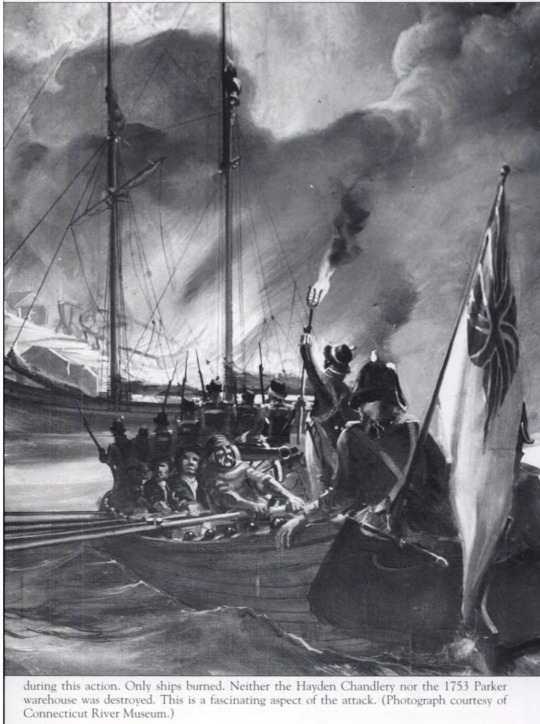
One immediate result of the raid was the demise of the old 1797 ropewalk, and a new larger one built 200 feet to the north. This change set for current street layout and appearance of Essex. Up until then, most commercial activity in Essex Village had centered in Champlin Square, with the Pratt Smithy and Ebenezar Hayden Store.
2 notes
·
View notes
Text
Royal Irish Regiment soldiers who died on 20th July
1918
2nd Bn
5520 Corporal William Devereux, Wexford.
11511 Lance Corporal Thomas Gill, Edenderry, Co. Offaly.
10558 Lance Corporal Richard Gregory, Wallingford, Berkshire.
3570 Private James Brolly, Ballyeney, Co. Tyrone
11438 Private John Gott, Templemore, Co. Tipperary.
18567 Private John Marshall, Leicester.
16045 Private Hamilton McAleer, Six Mile Goss, Co. Tyrone.
6073 Private Walter McCarthy, London.
All of the above are commemorated on the Pozieres Memorial.
18538 Private Thomas Devlin, Newtownards, Co. Down. Interred Hawthorn Ridge Cemetery No.1, Auchonvillers, France.
2 notes
·
View notes
Text
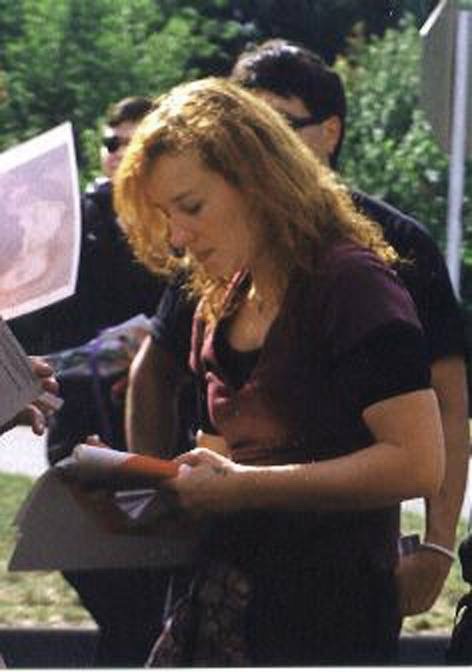
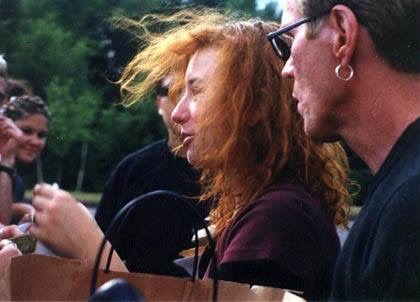


4 August 1998 Wallingford, Connecticut by Sara C. courtesy of dearest Richard
6 notes
·
View notes
Link
WRecognizing Features hat is Astrology and astronomy Rstrologer– stargazer richard of wallingford is indicated estimating an equatorium with a couple of compasses in this fourteenth century work. HISTORY
1 note
·
View note
Text
Katty Kay Wiki, Biography, Age, Profession, Boyfriend, Networth & Facts
Katty Kay Wiki:- In this article, we bring all the information about Katty Kay, a professional writer, actress, and broadcaster as well as a British journalist. She was born in Wallingford, United Kingdom. Katty details just like her career & early life and Katty Kay Wiki, KattyBenso Biography, Katty Age, Katty Profession, and more things that you want to know about her.
Katty Kay Wiki
Katty was born on 14 November 1964 in Wallingford, United Kingdom. By profession, she is a British journalist, writer, and broadcaster. Recently she left the US media firm. She is best known for working for Jeopardy! (1984), BBC World News America (2007), and the US presidential election (1928). She is working as Lead Anchor at BBC since 2011. She is working as a contributor and guest host for Morning Joe at MSNBC.
Katty Kay Career & Early Life
Katty was born in Wallingford, United Kingdom.
She is a British journalist, writer, and broadcaster.
Katy has been co-chair of the International Women's Media Foundation since 2009.
She has been working as a contributor and guest host for Morning Joe on MSNBC since 2009 in the Greater New York City Area.
She began her career as a Tokyo correspondent at BBC News in 1992 and left in 1996.
Katy became a London-time correspondent in 1999 and left in 2002.
Katty Kay Biography
Katty is a British-born journalist, writer, and broadcaster. Katy worked as a Washington correspondent for the BBC from 2002 to 2011. She is working as Lead Anchor at BBC since 2011. She was completed Secondary education at Grade Schools in Morocco And she has completed her Graduation from St Hilda, Oxford University. She holds British nationality. Her religion is Chrisitan. She started her career as a journalist.
What Is Katty Kay Net Worth?
As you know that Katty is one of the most popular American journalists and her net worth income is $1 million approx.
Katty Kay Ethnicity
She has white ethnicity.
Katty Kay Husband Name/Parents
Katty Kay Father's Name
Not Known
Katty Kay Mother's Name
Not Known
Katty Kay Husband's Name
Not Known
Katty Kay Wiki, Age, Profession, Career, Family, Height
Real Name
Katty Kay
Birth Name
Katherine B. Kay
Nickname
Katty
Profession
British Journalist
Marital Status
Married
Husband Name
Thomas Richard Carver
Children
Four
Zodiac
Not Known
Physical Status
Age
56 Years
Height
5 feet 10 inches
Weight
65 kg
Eye Colour
Blue
Hair Colour
Blonde
Personal Information
Date of Birth
14 November 1964
Birth Place
Wallingford, United Kingdom
Current Resident
Washington, District of Columbia, United States
Religion
Chrisitan
Nationality
British
School Name
Grade Schools in Morocco
College Name
St Hilda, the Oxford University
Qualifications
Graduate
Family Background
Father Name
Jolyon
Mother Name
Shirley Kay
Siblings
2 brothers and 1 sister
Career
Source Of Income
Journalist
Net Worth
$1 million (Approx.)
Favorite
Favourite Sports
N/A
Favourite Movie
N/A
Favourite Colour
N/A
Favourite Actor
N/A
Favourite Actress
N/A
Favourite Food
Pizza, Snacks, Fast Foods
Ans. She is 56 years old.
Ans. She has an American Nationality.
Ans. She has a 5.10 Feet height approx.
Ans. She is 5.10 feet tall.
Ans. She belongs to the United Kingdom.
Ans. She belongs to the Christianity religion.
Ans. She has white ethnicity.
Source Link
0 notes
Text
Mass Tourism-A Case Study on the Balearic Islands

The attempt to define mass tourism requires an explanation of the word itself. As Aragu,Garcia-Mestanza and Cabellero-Galeote said (2021,2) “mass tourism is related to the carrying capacity of a territory that is, the reaction and resilience of an environment to certain occupational density, expressed in a limit occupation figure.”. Which means in short, a large number of tourists travel to the same holiday destination and accuses problems that are related to the environment and to the locals living in that country. In this essay we will take a closer look on these causes and how to turn it into sustainable tourism, concentrating on examples based on the Balearic Islands.
But first we have to discuss what make theses places so popular. The Balearic Islands are famous holiday destinations because of their rich culture, gastronomy, beautiful sceneries and the climate which allows tourist to visit the islands also during off-seasonal periods. (Kozak&Rimmington,2000). Without a doubt tourism brings a lot of positive impacts in a country but also to travelers. It is helping foreigners to wide-open their cultural horizons and helping them to understand and respect different cultures and religions. It is also increasing employment opportunities but, the main visible benefit is, it is boosting the country’s economy. Which leads then to positive side-effects like keeping and improving of natural resources and its surroundings. (Pereira&Martins,2018). However, every advantage is secretly bringing disadvantages with it. In our case this is happening when tourism turns into “mass tourism”. According to the Spanish Tourism Institute (Frontur,2006) Mallorca welcomed 79.1% of the international visitors to the Balearics. It turns out that the instantly rising tourism in one area caused many problems. Some of them are the environmental degradation, packed beaches, anti-social behavior, water shortages caused by the high numbers of visitors which are increasing the demand for agriculture and seasonal water. (Andrews,2017). The key of changing “mass” tourism into something positive is to turn it into “sustainable” tourism. As Dodds,Rachel and Butler, Richard said (2010, p.46) “Sustainability means working with what exists to improve it”. But, for this to be achieved and for new laws to be executed there will be the need the support and coordination from higher level governments. (Dodds&Rachel and Butler&Richard,2009). Therefore, they established the tourism taxation in 2016 for the Balearic Islands, to raise extra money for reducing mass tourism and for helping the environment. (Moreno&Otamendi,2017). Also, the tourism sector in a country is now aware of consequences when a specific group of people may will overcrowded one site of their country and they are also trying to not over cross the carrying capacity in order to avoid mass tourism. (Pereira&Martins,2018). Another plan they made is to create new travel concepts to attract more upscale visitors, for e.g. so did Malta with the golf tourism. (Dodds&Rachel and Butler&Richard,2009). However also the water shortages in Mallorca, Spain is a major problem caused by mass tourism. Therefore, they introduced technical measures and policies to encourage the sensible use of water and the extravagant use by consumers. (Kent&Newnham&Essex,2002). To sum up let us pointed out once again that “mass” tourism only can be stopped if all the sectors economic, social and environmental will move forward together. We have to stop thinking of the problems and causes and start act active for a “sustainable” tourism. A tourism which is “healthy” for the travelers but also for the country we are traveling in.
Bibliography
Harrison. & David. & Sharpley. & Richard (2017) Mass Tourism in a small world, Oxfordshire,Wallingford,UK.
Aragú M, García-Mestanza J, Caballero-Galeote L. Stakeholders’ Perception on the Impacts of Tourism on Mass Destinations: The Case of Seville. Sustainability. 2021; 13(16):8768. https://doi.org/10.3390/su13168768
Dodds, Rachel and Butler, Ryerson R. Barriers to implementing Sustainable Tourism Policy in Mass Tourism Destinations University, University of Strathclyde 22 August 2009 Online at https://mpra.ub.uni-muenchen.de/25162/ MPRA Paper No. 25162, posted 20 Sep 2010 02:36 UTC TOURISMOS: AN INTERNATIONAL MULTIDISCIPLINARY JOURNAL OF TOURISM Volume 5, Number 1, Spring 2010, pp. 35-53
Garcia E., A. La satisfacción del turista en España.Un análisis de los estudios Familiatur y Frontur. Estudios Turísticos, ISSN 0423-5037, Nº. 168, 2006, págs. 47-59
Kent M. ,Newnham R. , Essex S. Tourism and sustainable water supply in Mallorca: a geographical analysis Department of Geographical Sciences, University of Plymouth, Drake Circus, Plymouth, Devon PL4 8AA, UK Received 29 June 2001; received in revised form 3 May 2002; accepted 27 May 2002
Kozak. M., Remmington M. Tourist satisfaction with Mallorca, Spain, as an off-season holiday destination (2000), journal of travel research
Moreno M. J., Otamendi J., F., Fostering Nautical Tourism in the Balearic Islands Received: 30 October 2017; Accepted: 27 November 2017; Published: 30 November 2017Escuela Internacional de Doctorado, Universidad Rey Juan Carlos, Madrid 28933, Spain; [email protected] or [email protected] 2 Escuela Universitaria de Turismo Felipe Moreno, Universitat Illes Baleares, Illes Balears 07122, Spain
Pereira P., Martins J., Sustainable Heritage Managment Towrads Mass Tourism Impact: THE HERIT-DATA Project 2018 International Conference On Intelligent Systems (IS)
1 note
·
View note